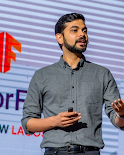
Gaurav Mishra
Gaurav Mishra is an Engineering and Research Lead on sequence modeling research and foundation models at Google Brain. He is passionate about Machine Learning (ML) Infrastructure and Natural Language Understanding (NLU) Systems. In his Google career, he has also worked on Google's production NLU platform. Gaurav holds a Bachelor's degree in Electrical Engineering from IIT Delhi. He enjoys music and travel.
Authored Publications
Google Publications
Other Publications
Sort By
PaLI: A Jointly-Scaled Multilingual Language-Image Model
Piotr Padlewski
Daniel Salz
Sebastian Alexander Goodman
Basil Mustafa
Keran Rong
Hassan Akbari
Linting Xue
James Bradbury
Carlos Riquelme
International Conference on Learning Representations (ICLR) (2023)
Preview abstract
Effective scaling and a flexible task interface enable large-capacity language models to excel at many tasks. PaLI (Pathways Language and Image model) extends these ideas to the joint modeling of language and vision. PaLI is a model that generates text based on visual and textual inputs. Using this API, PaLI is able to perform many vision, language, and multimodal tasks, across many languages. We train PaLI with two main principles: reuse of pretrained unimodal components, and joint scaling of modalities. Using large-capacity pretrained language models and vision models allows us to capitalize on their existing capabilities, while leveraging the substantial cost of training them. We scale PaLI models across three axes:the language component, the vision component, and the training data that fuses them. For the vision component, we train the largest and best-performing VisionTransformer (ViT) to date. For the data, we build an image-text training set over10B images and covering over 100 languages.
PaLI inherits and enhances language-understanding capabilities, and achieves state-of-the-art in multiple vision and language tasks (image classification, image captioning, visual question-answering, scene-text understanding, etc.), based on a simple, modular, and reuse-friendly platform for modeling and scaling.
View details
PaLM: Scaling Language Modeling with Pathways
Aakanksha Chowdhery
Sharan Narang
Jacob Devlin
Maarten Bosma
Hyung Won Chung
Sebastian Gehrmann
Parker Schuh
Sasha Tsvyashchenko
Abhishek Rao
Yi Tay
Noam Shazeer
Nan Du
Reiner Pope
James Bradbury
Guy Gur-Ari
Toju Duke
Henryk Michalewski
Xavier Garcia
Liam Fedus
David Luan
Barret Zoph
Ryan Sepassi
David Dohan
Shivani Agrawal
Mark Omernick
Marie Pellat
Aitor Lewkowycz
Erica Moreira
Rewon Child
Oleksandr Polozov
Zongwei Zhou
Michele Catasta
Jason Wei
arxiv:2204.02311 (2022)
Preview abstract
Large language models have been shown to achieve remarkable performance across a variety of natural language tasks using few-shot learning, which drastically reduces the number of task-specific training examples needed to adapt the model to a particular application. To further our understanding of the impact of scale on few-shot learning, we trained a 540-billion parameter, densely activated, Transformer language model, which we call Pathways Language Model PaLM. We trained PaLM on 6144 TPU v4 chips using Pathways, a new ML system which enables highly efficient training across multiple TPU Pods. We demonstrate continued benefits of scaling by achieving state-of-the-art few-shot learning results on hundreds of language understanding and generation benchmarks. On a number of these tasks, PaLM 540B achieves breakthrough performance, outperforming the finetuned state-of-the-art on a suite of multi-step reasoning tasks, and outperforming average human performance on the recently released BIG-bench benchmark. A significant number of BIG-bench tasks showed discontinuous improvements from model scale, meaning that performance steeply increased as we scaled to our largest model. PaLM also has strong capabilities in multilingual tasks and source code generation, which we demonstrate on a wide array of benchmarks. We additionally provide a comprehensive analysis on bias and toxicity, and study the extent of training data memorization with respect to model scale. Finally, we discuss the ethical considerations related to large language models and discuss potential mitigation strategies.
View details
Beyond the Imitation Game: Quantifying and extrapolating the capabilities of language models
Aitor Lewkowycz
Daniel Freeman
Guy Gur-Ari
Jascha Sohl-dickstein
Liam B. Fedus
TBD (2022)
Preview abstract
Language models demonstrate both quantitative improvement and new qualitative capabilities with increasing scale. Despite their potentially transformative impact, these new capabilities are as yet poorly characterized. In order to direct future research, prepare for disruptive new model capabilities, and ameliorate socially harmful effects, it is vital that we understand the present and near-future capabilities and limitations of language models.
To address this challenge, we introduce the Beyond the Imitation Game benchmark (BIG-bench). BIG-bench consists of 207 tasks, contributed by over 400 authors across 132 institutions. Task topics are diverse, drawing problems from linguistics, childhood development, math, common sense reasoning, biology, physics, social bias, software development, and beyond. BIG-bench focuses on capabilities that are believed to be beyond current language models. We evaluate the behavior of OpenAI's GPT models, Google-internal dense transformer architectures, and Switch-style sparse transformers on BIG-bench, across model sizes spanning millions to hundreds of billions of parameters. A team of human experts further performed all tasks, to provide a strong baseline. Findings include: model performance and calibration both improve with scale, but are poor in absolute terms (and when compared with human performance); model performance is remarkably similar across model classes; tasks that improve gradually and predictably commonly involve a large knowledge or memorization component, whereas tasks that exhibit ``breakthrough'' behavior at a critical scale often involve a significant reasoning or algorithmic component; social bias typically increases with scale in settings with ambiguous context, but this can be improved with prompting.
View details
No Results Found
